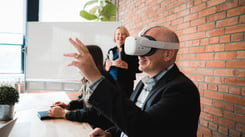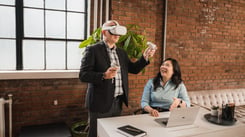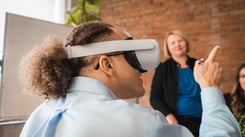Virtual Reality (VR) has quickly become an asset in the architect’s toolbox, breathing life into their designs. Given the overall rise in popularity and availability, VR has become one of the preferred solutions in answering some of the barriers you may have in your project’s process. As businesses and firms continue to recognize the practicality and functionality that VR for architects provides, this technology continually moves past entertainment and into Enterprise.
How to Use VR in Architecture
In a broad sense, VR builds a bridge between some points of friction you may face during a project’s external and internal process.
External
We have previously covered in our post last week how using VR could aid in external interaction, especially with your clients. One of the key components of a successful designer-client relationship is clear and effective communication. As an architect, you are accustomed to reading and deciphering a floorplan of a space, however, your clients may not even know any of the technical terms commonly used in your field. Immersing your clients in VR allows you to share your vision in a way they can easily understand.
Internal
Your final product that is on display in center stage for your clients to see is the result of hard work behind the scenes. And the beauty of VR is that it’s versatile enough to be applied to all areas of your workflow. Using VR for architecture has many key benefits especially during the internal design development stage.
So how exactly would VR be useful for architects and designers?
“Architects and designers in our worldwide offices are now using VR technology on a daily basis to discover new insights into their design ideas.”
The Ultimate Validation Tool
As with any project, there is the limitation of wanting to churn out your client’s vision in a timely manner. Having a fast turnover rate helps you stay competitive, professional, and client-focused. However, there are projects that will be more challenging than others, and having a clear sense of direction not only helpful, but it will be critical in concluding a project efficiently. In order to do so, seeing design information efficiently will be a crucial part of the process of getting from start to finish. Whether the challenge is a limited office area or a huge concert auditorium, VR provides a solution to communicate more efficiently with greater clarity.
“We can get into a challenging space and immediately understand if it feels and works the way we intended. It’s a much faster way to look at design information. I just spent 30 seconds inside this interactive model and saw the amount of information that might have taken 20 different drawings to communicate.”
Eli Hoisington, Design Principal, HOK St. Louis Office

Being able to see your space makes all the difference. Not only does it make it clearer to you, the individual designer, but to the rest of your team. Information that would have been challenging to communicate previously is understood instantly when stepping into your project in VR. Plus, it gives you the opportunity to discuss with your team the feasibility of certain structures your client may have requested. Whether the design or configuration isn’t functional or you’re unsure about what the quality of the end result would be, utilizing VR as a validation tool helps you understand the flaws of your design, and promotes discussions on how to fix it.
Enhance Your Communication
On that same wavelength, the clarity that VR provides is helpful during the revision process amongst your colleagues. As Eli pointed out, stepping into your design in VR helps you immediately understand what the space feels like and if it turned out the way you expected. Although it’s a great feeling when the result is better than you hoped for, using VR in architecture highlights improvements needed in your design.
“Throwing our design into VR would quickly reveal tasks and revisions we needed to accomplish and help us figure it out much more quickly in the design process.”
Like Andrew was saying, viewing your design in VR helps you and your team to catch any errors that may not be necessarily noticeable in drawings. On top of that, it gives the opportunity to brainstorm more ideas for making a certain area or structure more efficient, practical, or aesthetically pleasing to take your design to the next level. Being able to iron out the last remaining creases will be useful in finalizing a design before presenting it to your client for further revisions.
Furthermore, fostering good communication is not only valuable when interacting with your clients, but also amongst the team. Understanding your fellow designer’s struggle with an area of the design or pointing out areas of enhancement is all part of encouraging cohesion in your team. With breaking the visualization barrier, VR promotes clearer collaboration with your design team.
Share Your Design Remotely
VR has become more advanced and readily available, creating a variety of VR business-ready solutions suitable for any company. Many architecture firms have opted to adopt the tetherless VR option as it allows for greater flexibility and mobility of transport. Additionally, it’s a more cost-effective route as tethered VR requires a powerful computer to support the program and the headset. While you can pass along the headset to your colleagues and clients when you meet with them in person, a number of business-ready VR companies have made it possible to share your designs remotely.
Here at Yulio, we have simplified the sharing process and thought about how you really work so you can collaborate with your team or your clients anywhere in the world. Our Collaborate feature is our most used feature and allows you to present your design to your clients, colleagues, and prospects around the world or in the same room. Enjoy the freedom and flexibility of allowing your team to peruse through your design while also having the option to spotlight certain areas for their feedback. Plus, with our gaze indicators, you can always see what your client is looking at and get context for their comments and feedback. Whether your team is in the same room as you or on the other side of the world, remote participants can join in from anywhere on both headset or our browser-based fishtank mode. Your clients and prospects don’t require a headset or Yulio seat to view a Collaborate session in our browser mode, so there are no barriers to sharing your vision.
Being able to share your projects in this way is useful to both small and large firms. Whether you’re working as a freelance architect or your firm has numerous offices worldwide, being able to share your project has never been easier.
“Mobile VR worked better for us because it gave us the opportunity to communicate through everyday, accessible objects like smartphones.”
Andrew Chung, Diamond Schmitt Architects
The Value of VR for Architects
VR is a malleable and versatile platform, allowing architects to implement it into various areas of their project workflow. Primarily in a project’s design development stage, VR is a useful tool to foster greater communication between your design team. As a result, VR can encourage a flow of ideas on how to further improve your design and push you to be the best designer you can be.
Here at Yulio, we strive for excellence in performance and integrity when it comes to our product, and customer service. Check out our Whitepaper on the right way to integrate VR into your business for maximum ROI. To learn more about us and what we offer, please visit our page or take our product tour.







